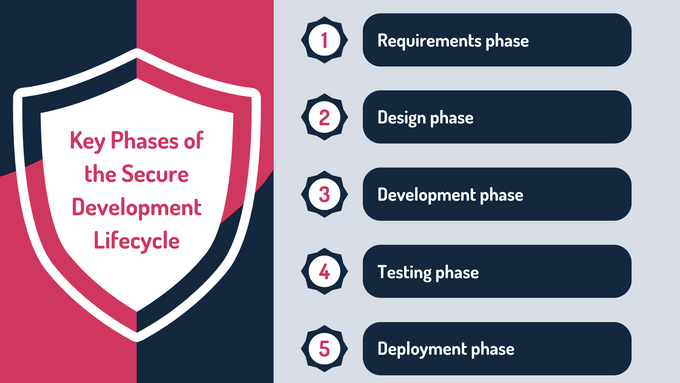Secure Development Lifecycles & Their Value in Cybersecurity
Learn how integrating security into each stage of software development protects your applications and reduces risks with a secure development lifecycle.
Published March 23, 2025.

Building secure software requires more than just addressing issues after they occur. A secure development lifecycle (SDL) integrates security throughout the software development process. By incorporating security measures at each phase, from design to deployment, SDL helps prevent vulnerabilities and ensures your systems are better protected against evolving threats.
It’s an essential approach to creating resilient and secure software in today’s digital landscape. In this blog, we will explore the importance of SDL and how it can enhance your cybersecurity strategy.
» Contact us for expert cybersecurity guidance tailored to your business needs.
What Is a Secure Development Lifecycle?
The secure development lifecycle (SDL) is a process that has security touch points incorporated into every stage of the development lifecycle (from requirements stage through to the deployment stage). Each phase of the SDL must contribute to the security of the overall application.
» Learn more about the secure development lifecycle
Traditional Software Development Lifecycle vs. Secure Development Lifecycle
| Phase | Traditional SDL | Secure SDL |
|---|---|---|
| Requirements | Focuses on gathering functional and business needs | Risk assessment is conducted to identify potential security threats early |
| Design | Emphasizes system architecture and functionality | Threat modeling and design review help anticipate security vulnerabilities |
| Development | Writing and implementing code | Static analysis of the code is done when the code is not executed to detect flaws |
| Testing/Verification | Ensures that the software works correctly by comparing the expected and actual output based on given inputs | Includes additional security-focused tests such as dynamic code analysis, code review, and security testing. Other tests like performance, regression, unit, integration, system, and acceptance testing are also conducted |
| Deployment, Maintenance, and Evolution | Focuses on deploying the software and providing regular updates | Adds security assessments and secure configuration. Default platform settings are disabled, and configurations are hardened to minimize attack surfaces |
» Here's what you should know before hiring a risk assessment provider
Security Failures in Traditional Software Development Models That Led to SDL
The traditional software development model, often referred to as the waterfall approach, is rigid and follows a top-down structure. This lack of flexibility results in several security challenges:
- The top-down approach contrasts with the Agile nature of SDL, which is more adaptable
- The design phase can’t begin until the requirements phase is complete, delaying progress
- If a flaw is discovered during development, the process must reverse, which is time-consuming and costly
- Frequent adjustments to requirements are difficult, limiting adaptability
- The traditional model often takes longer to deliver a working product
Key Phases of the Secure Development Lifecycle
1. Requirements Phase
At the requirements stage, the primary security activity is risk assessment. This helps identify potential attack surfaces early and allows for the development of strategies to mitigate them. The risk assessment focuses on identifying critical application interfaces and how they might be exploited by attackers.
Security Risks
- Incomplete requirements that could lead to project failure
- Susceptibility to vulnerabilities like broken authentication and SQL injection
» Make sure you know what's involved in the risk assessment process
2. Design Phase
The design phase focuses on threat modeling and design review. Several frameworks, including STRIDE, the OWASP Top 10, and Mitre Att&ck Framework, are used to identify potential threats. These frameworks help ensure the design accounts for both known and emerging security risks.
Security Risks
- Missing prevalent threats due to an ever-changing threat landscape
- Insufficient use of appropriate controls to mitigate identified risks
- Risk of cost optimization affecting security
3. Development Phase
During the development phase, static code analysis is conducted. This involves reviewing the code for security flaws without executing it. Tools like SonarQube are used to compare the code against global best practices, minimizing vulnerabilities before they can be exploited.
Security Risks
- Vulnerable or exploitable code
- Missing strong authentication factors like multi-factor authentication (MFA)
» Learn how to boost your security with the CIA triad
4. Testing Phase (Verification & Validation)
At the testing stage, software undergoes verification and validation, ensuring that it meets the specified requirements before deployment. Various tests, including unit, regression, and security tests, are carried out, either manually or automatically, to ensure the software functions securely.
Security Risks
- Weak or vulnerable integration elements, such as APIs
- Exposure to cyber attacks that could lead to data breaches and reputational damage
5. Deployment, Maintenance, and Evolution Phase
In the deployment and maintenance phase, secure configurations are implemented during the setup and use of the application, such as disabling default configurations. Additionally, ensuring the correct functionality of all modules and providing continued support is crucial to maintaining software security over time.
Security Risks
- Exploitable configurations if not hardened
- Potential financial loss and reputational damage if vulnerabilities are not addressed
» Learn how to streamline secure development for faster delivery
Frameworks Supporting the Secure Development Life Cycle
Microsoft Security Development Lifecycle (SDL)
- The Microsoft SDL is a set of practices that ensures security is integrated throughout the development process, from the design phase to the release and maintenance stages.
- It includes guidelines on threat modeling, security testing, and code review, among other activities, to help developers minimize security vulnerabilities in their applications.
MITRE ATT&CK Framework
- The MITRE ATT&CK Framework is a comprehensive knowledge base of cyberattack tactics and techniques, based on real-world observations. It helps organizations understand the ways in which cybercriminals exploit systems.
- By integrating this framework into the SDL, organizations can proactively design and develop software that can better resist known attack methods, enhancing overall security.
OWASP Software Assurance Maturity Model (SAMM)
- OWASP SAMM is a framework for assessing, developing, and improving software security practices.
- It evaluates an organization's security maturity across domains like governance, design, testing, and deployment, promoting continuous improvement and adaptability for any organization.
SSDF (Supported by PCISSC)
- The Secure Software Development Framework (SSDF) provides guidelines for secure software development, focusing on secure coding, testing, and vulnerability management.
- It is particularly useful for organizations handling sensitive data, such as those involved in financial transactions.
Importance of Integrating Security in the Development Lifecycle
- Security prioritization: Security must be prioritized throughout the development life cycle, as attackers have become more cunning and aggressive, utilizing sophisticated tools at various stages of the attack/cyber kill chain.
- Security as a business issue: Security is no longer just a technical issue; it’s a business issue. With the erratic rate of technological innovation, attacks have become a constant threat.
- Attack-in-depth strategy: Attackers now employ an attack-in-depth strategy, inspired by the defense-in-depth methodology from the OSI model, making it crucial to integrate security early to defend against complex threats.
- Reliable, secure software: Integrating security early helps deliver highly secure and reliable software, which allows the organization to gain the trust of its customers.
- Proactive risk management: A proactive approach to security management helps reduce risks over time, making it cheaper and easier to manage security concerns in the long run.
- Cost savings: Security vulnerabilities discovered later in the SDLC, particularly after deployment, are exponentially more expensive to fix as they require rework of existing code, potential redesigns, and even infrastructure changes. It can be up to 6 times more expensive than fixing a vulnerability before deployment.
» Discover the disasters you can avoid by tackling cybersecurity on time
How GRSee Consulting Can Help Your Organization Integrate a SDL
At GRSee Consulting, our cyberservices can help your organization embed security into your software development process. From the initial risk assessments during the requirements phase to threat modeling, design reviews, and even managed DevSecOps that help you shift development left to integrate security throughout the SDLC, we’re with you every step of the way to ensure your software is deployed with secure configurations and offer continuous support to maintain its security. With our expertise, your organization can deliver reliable, secure software while reducing the risk of cyber threats.
» Ready for help? Contact GRSee to learn how we can secure development for your organization





